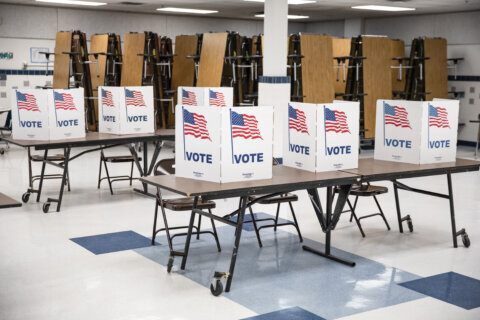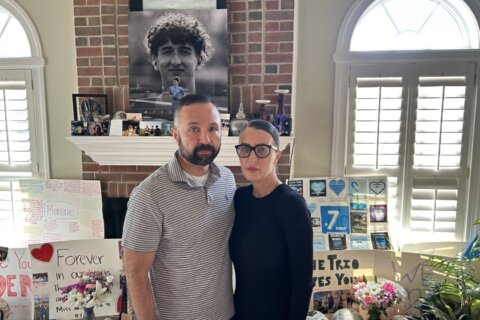When Kevin Davis was a rookie cop 30 years ago, every work day began the same way.
“My sergeant would end roll call by telling us not to let any other police officer beat us to a call for service in our patrol beat,” he told WTOP.
Sounds good on the surface, but Davis said it instilled a message: “Get there fast enough, and handle it, and be done with it, and move on to the next call. Don’t think; just do. React, react, react and move on.”
As police chief in Fairfax County, Virginia, Davis said, he wants to instill a different message.
“Hurry up and slow down,” Davis told WTOP’s “DMV Download” podcast in an exclusive conversation on the occasion of his first anniversary as chief. “Slow down. Let’s get it right. You don’t need to get into a situation.”
Listen to the podcast
Toward that end, he said, he’s introduced integrating communications assessment and technology training — which he called the “gold standard use-of-force training” — to the department. The training is based on a U.K. model of policing, and Davis called it “de-escalation on steroids.”
“We’ve seen it all too many times in American policing throughout the country, where [the use of force is] legally justified,” Davis said, “but it’s one of those ‘lawful but awful’ circumstances. Did it need to happen? And if we use time and distance to our advantage, and if we instill that training into our cops, cops are likely to make better choices under stress.”
The training includes time spent in the community, and WTOP’s Megan Cloherty said several Fairfax County officers she talked with characterized it as “appearance over substance” – a box they have to check before they can get back to real work – and that it was one of the factors leading officers to consider retirement or a different job.
“I’m familiar with the challenges that public safety has any time changes are introduced,” said Davis, who pointed out that his father was a police officer and that his grandfather and great-grandfather were D.C. firefighters. “As a culture, I think sometimes policing is resistant to change.”
That time spent in the community amounts to a half-hour out of an 11-and-a-half-hour shift, Davis said – preferably two 15-minute stints. “We want you to get out of your car … and simply interact with people in a non-law enforcement capacity in the community,” Davis said. “It can be in the neighborhood; it could be in the grocery store; it could be at a school; it could be at a playground.”
The key is to build trust, Davis said, and “the time … you build trust is not when there’s a crisis. We have to build trust left of boom, because I think police officers, police departments, are always trying to build trust right of boom, and sometimes that’s too late.”
He added, “I want our community to know us before they need us.”
Trends in crime
Some types of crime are on a steep rise in Fairfax County, Davis said.
There were 21 murders in the county last year, which he called “a small raw number” in a county of 1.23 million. That said, nearly a third of those incidents were committed by adult children killing a parent they lived with, which Davis ascribed in part to “the pandemic and the isolation and the depression and the anxiety,” particularly among people already suffering from mental or behavioral problems.
Domestic violence calls are up 32% this year over last, Davis said. The department’s policy has been to encourage the reporting of domestic crimes, he said, “particularly in vulnerable communities, particularly in the Hispanic community, where there’s been historically, here and elsewhere, great reluctance to report domestic violence.”
Car thefts are also on the rise, Davis said – up 26% over last year – as are carjackings, which Davis called “one of the crimes that scares me the most.”
“It’s committed by young men, plural,” Davis said. “And they’re armed, and they’re scared, and they’re amateurs. And we’ve seen all too often in the National Capital Region where a carjacking turns into a murder, and it’s horrific.”
That’s why the Fairfax County department has formed its first Auto Crimes Enforcement Team, echoing an initiative from Prince George’s County, one of Davis’ former employers.
“We did not have a full-time commitment to auto theft enforcement in Fairfax County,” Davis said. “We do now.”
The other car crime that’s on the rise: catalytic converter theft, which Davis said is “driving our crime.”
It’s relatively easy with the right tools, and it’s lucrative, the chief said.
“The precious metals that are contained in these catalytic converters are worth a lot more now than they had been in the past,” Davis said, and stealing one “takes about one to two minutes depending on the skill level of the thief.” The most targeted vehicles? Toyota Priuses made between 2004 and 2009.
Keeping cops and attracting new ones
Fairfax County has 1,350 officers out of an authorized strength of 1,484, Davis said. That’s a vacancy rate of 9%, which the chief said was in line with the rest of the country, although “that doesn’t make it acceptable.”
He added that there wasn’t a real spike in retirements. “It’s the resignations that spiked,” he said. “Young people who were leaving policing, not for another police department, but for other professions: anesthesiologist, carpenter, IT sales. I mean, you name it.”
The department is doing a few things to help boost the numbers, he said, including a budget enhancement; a change to make it easier for cops from other areas to move in and work in the county; and a move off a “hard-and-fast rule” prohibiting anyone with drug offenses from ever joining the force.
But the real problem, he said, was getting people to consider becoming a police officer in the first place. Five or six years ago, Davis said, the Fairfax County department drew 4,100 applicants; last year, 1,500.
It happens whenever “our profession has been under scrutiny,” Davis said, but he added: “You get better from scrutiny. … I’ve led several organizations at significant times of local and national crisis, and I believe crisis ultimately makes you better, stronger, and it improves policing.”
Davis became a police officer as a 22-year-old with an English degree, and he said attracting such younger people is paramount. Other police chiefs he talks with tell him they’re facing the same problems, and they understand why.
“We’re all relatively like-minded. And in our goal to improve policing, there’s nobody digging their heels in saying ‘We wish for the good old days,’ because the good old days weren’t always the good old days, and sometimes policing has been on the wrong side of history,” he said. “So I think we all collectively agree we got to get better. But we need to find a way to attract young people to our profession to make it better. And it’s not just compensation.”
The phrases “work-life balance” and “quality of life” weren’t in his vocabulary in his 20s, he said — “I would look much younger if they were.” But young people now put such considerations at the forefront, “and maybe they’re better off for it.”
The Timberlake case
That scrutiny on the police started nationwide after the murder of George Floyd at the hands of the Minneapolis police in May 2020, but a month after that, Fairfax County had its own controversy centering on use of force.
Officer Tyler Timberlake was acquitted this March of assault and battery charges after he used his stun gun several times on Lamonta Gladney in June 2020 in the Mount Vernon area.
Gladney had been walking around in the middle of the street and was audibly rambling, another officer reported at the time. He reportedly had PCP in his system, it was reported afterward, and Timberlake’s lawyer said his client “recognized it right away.” Timberlake was put on administrative leave.
Davis wasn’t chief then, but officers told WTOP’s Cloherty and Luke Garrett that the whole affair took a toll on morale.
The chief said that gaining the trust of officers and of the community weren’t mutually exclusive things.
“Just because someone wants us to get better doesn’t mean that they’re at odds with us,” Davis said. “What cops want — and what the community wants for people who are engaged in the criminal justice system — is due process.”
He added that that would help in retention and building a new base of officers: “Building trust within the agency and ensuring cops know that I’m a due process police chief, I think, bodes well for incumbent officers and hopefully attracts new officers to our profession.”
That’s his No. 1 goal as he enters Year Two in the top job.
Of the 134 empty jobs, Davis said, “at first blush, it seems like it’s a big number, and it’s bigger than we’ve ever seen. But it’s not insurmountable. So we probably need to double the size of our police academy classes for a couple years, encourage our incumbent officers to stay, stay engaged, stay with us at tough moments.”
He added, “I look for people who kind of bear down and [think] let’s get through this together.”








